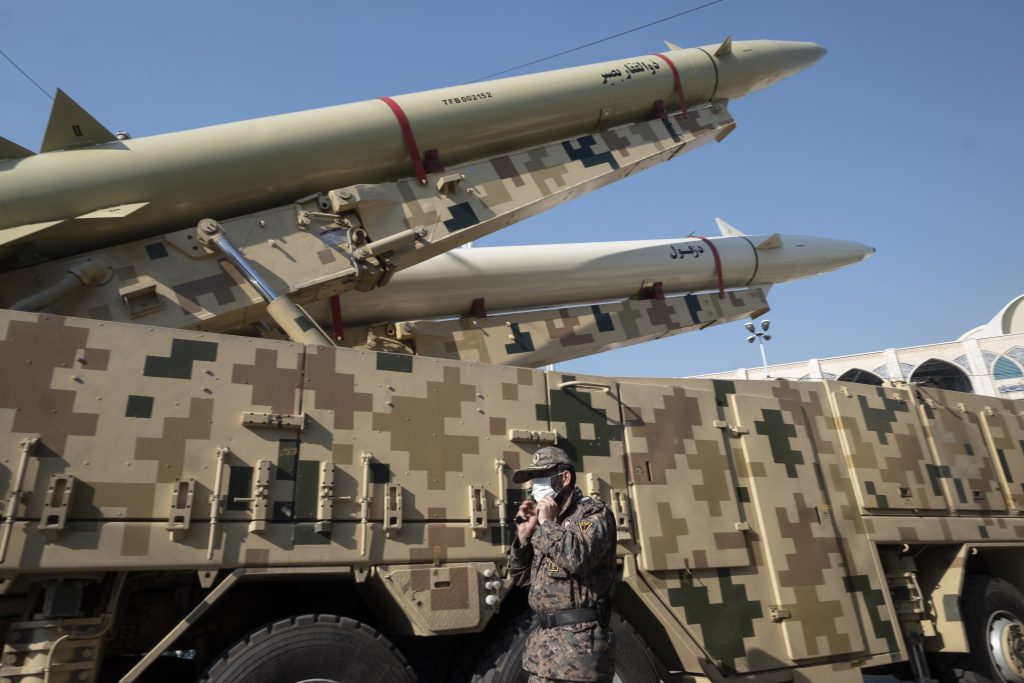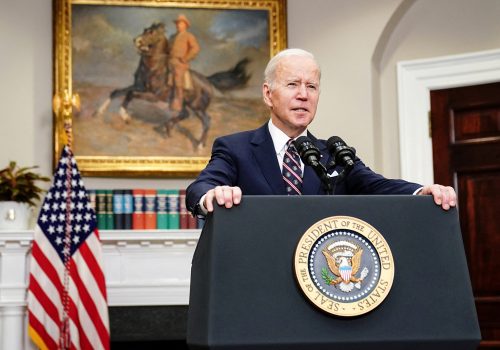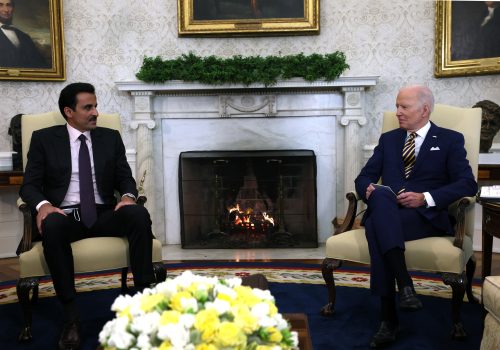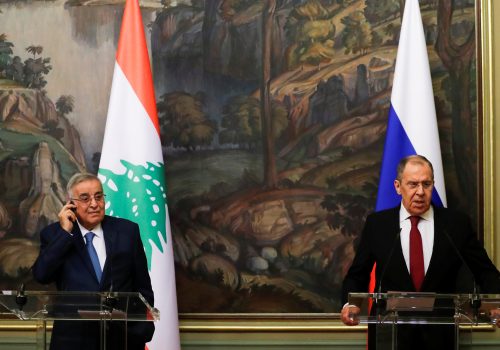Regardless of the outcome of nuclear talks between the United States and Iran, the Middle East must contend with a regime in Tehran whose foreign policy is both unambiguous and unapologetic about the strategic value it places on the transfers of drones, rockets, and missiles to militia groups conducting attacks across the region. This Iranian threat network facilitates and executes these attacks, which have notably escalated since 2019 and continue despite Saudi Arabia and the United Arab Emirates (UAE) opening a dialogue with Iran. A meddlesome Russia seeking leverage in the wake of its invasion of Ukraine is now an additional factor.
Diplomacy alone is not enough. Iran-backed attacks on economic infrastructure in Saudi Arabia, Israeli oil tankers in the Arabian Sea, partner military bases where US forces are hosted, and even high-profile politicians in Iraq are proof that international diplomatic efforts have not swayed Tehran. In late January, Houthi rebels launched a missile attack during the Israeli president’s historic visit to the UAE, followed by a drone and missile attack in Abu Dhabi that killed three. Weeks later, the Emirati Defense Ministry claimed it intercepted three hostile drones over the country’s airspace.
While the United States, its European allies, and Israel work to disrupt the supply chains that Iran uses to arm groups outside its borders, they have not taken large, conventional kinetic action against facilities responsible for the manufacture and transfer of weapons inside Iran. Congress has limited the US military’s ability to strike preemptively once transfers take place. Responding to cheap, modified Chinese or other commercial off-the-shelf drones with Patriot and Terminal High Altitude Area Defense (THAAD) batteries is unreliable, expensive, and unsustainable if this attack tempo continues or increases—particularly as Iran’s proxies become more proficient.
This is why US partners in the region should develop an integrated air and missile defense (IAMD), and policymakers in Washington should lend their full bipartisan support to this endeavor.
Changes in threats, players, and priorities
The US case for IAMD has, over several administrations, met no more than a lukewarm response from Gulf partners. A lack of trust among Gulf nations drove concerns about intelligence and information sharing with neighbors, stymieing plans for a region-wide network of defensive platforms. In any case, US prioritization of the region in recent decades lessened the need for Gulf partners to take full ownership of their security.
While the hesitancy to subordinate sovereign priorities for collective security has not waned, the conditions have changed. The Gulf states can no longer afford to rebuff the US offer to coordinate such a strategic defense against the well-recognized threat from the Iranian regime. The Abraham Accords also position Israel to play a contributing role in IAMD, if invited. The shift in US focus and resources from the Middle East to the Indo-Pacific, coupled with rising demands for air-defense platforms in other parts of the world, means that standby units may not always be available for use in the Gulf. The region has already witnessed the redeployment of several US air-defense systems away for maintenance, anticipating that they will be needed by US Indo-Pacific Command. This has long generated concerns among Washington’s Gulf partners over the future availability of these platforms.
While the US physical presence is decreasing in some quarters, US influence and leadership need not. The United States remains the preferred security partner for Gulf states—but China and Russia are increasingly attractive in the face of changing force posture and security cooperation. A US-backed IAMD would be a tangible way of demonstrating US commitment to Gulf Arab partners’ security. Moreover, US-led development and implementation would further the Biden administration’s objective of maintaining US advantage in a strategic power competition with China and Russia.
While Washington is hesitant to provide offensive military platforms to Gulf partners, support persists for working closely with them on IAMD rollout. A clear plan to procure and implement IAMD would be far more sustainable than an ad hoc approach to air-defense systems, and the United States could proceed without walking back established positions on withholding sales assessed as risks to human rights.
The State Department’s Bureau of Political-Military Affairs recently completed an interagency review of the US government’s Conventional Arms Transfer (CAT) policy, in light of the Biden administration’s prioritization of human-rights considerations. The range of outcomes for this review includes potential issuance of a new CAT policy that could meaningfully limit the categories of weapons or capabilities the United States will transfer to regional states. Such an outcome could also make it challenging to fulfill the stated security cooperation goals of the administration to “modernize our military capabilities, while leading first with diplomacy; and revitalize America’s unmatched network of alliances and partnerships.”
IAMD is a way to reconcile these priorities. Given that these systems are defensive in nature, the interim National Security Strategy and the current 2018 CAT policy already provide applicable guidance to ensure such IAMD-related transfers are in line with US national-security interests, to include maintaining technological superiority while providing the necessary capabilities to partners in the Gulf.
Foremost defensive security requirement
As recently as November 2021, Defense Secretary Lloyd Austin sought to reassure Middle East partners that the United States is committed to their security, even as the US military continues its pullback from the region. To prove the sincerity of this commitment, the United States should propose a new strategy—key elements of which should include a continued robust diplomatic dialogue to avoid surprises, a renewed diplomatic push to encourage practical cooperation among Gulf partners, a further strengthening of US military relationships with partners to counter robust Chinese military engagement, and a commitment with the support of Congress to address the key defensive security requirements in the region. IAMD is the foremost of these requirements.
To be clear, an effective system could create the conditions to allow a lower level of US combat troops. With US trainers and system maintenance personnel on the ground, working closely with regional host militaries, the United States would maintain an important presence in a key theater for strategic competition with Russia and China. Further, defensively countering the Iranian threat through IAMD responds to numerous US objectives, including unimpeded access to trade routes and protection of Israel.
IAMD does not pose an offensive threat to Iran, and the international community could make it clear to Tehran at the outset that offensive escalation ostensibly undertaken in response would not be justified. Most significantly, IAMD could serve as the basis for security cooperation and trust building among Gulf nations and potentially Israel.
But one challenge includes meeting increased global demand amid delays in US production of air- and missile-defense systems, including supply-chain disruptions due to COVID-19 that are prolonging platform delivery timelines. This dynamic generates competition among partners, since an accelerated delivery for one partner comes at another partner’s expense. Gulf partners also have other options for sellers—namely China and Russia—which is a new reality in the region. US policymakers will need to communicate transparent timelines and manage expectations to maintain goodwill with Gulf partners and discourage competition detrimental to effective IAMD.
A second challenge lies in convincing US partners that such an architecture will ultimately better defend their nations and not disadvantage one or some relative to the others in a collective defense. Each Gulf partner insists that any such collective efforts undertaken with the United States should not overshadow the bilateral relationship, a position with which Washington has long concurred.
A hub-and-spoke model of intelligence handling, with the United States as the hub, could assuage initial Gulf concerns about sharing intelligence with neighbors. As the threat from drones, missiles, and rockets accelerates, the rewards of IAMD would heavily outweigh the risks. Bilateral talks about mutual nonaggression, such as what Saudi Arabia and the UAE are engaged in with Iran, are encouraging but not fail-safe, and pursuing IAMD would strengthen the position of Gulf partners in these talks.
Long-term stability
Planning for IAMD should be independent of the outcome of the nuclear negotiations between Iran and world powers. Members of the US-Gulf Cooperation Council Working Groups affirmed this position last week in Riyadh, where discussions focused on the centrality of IAMD to countering the conventional threat from Iran. If a new Joint Comprehensive Plan of Action is reached, steps toward collective air defense will make the Gulf position stronger in follow-on talks promised by the US administration to address Tehran’s proxy and missile programs. If a new deal, should one materialize, falls short of its desired purpose, these steps will be a critical component in any “Plan B” for managing Iran’s destabilizing policies and disruptive posture in the region.
The time has come for the United States and Gulf states to focus on the most serious security issues at hand and to finally do the hard work to create an integrated system to protect against Iran-sourced attacks. An effort of this kind would also serve to consolidate trust between Gulf states, and between the United States and the Gulf—relationships critical to securing long-term stability in the region.
Russia had asked the Gulf to accept a concept for collective security defined by Russian interests, though the region’s leaders are approaching Moscow cautiously amid its war in Ukraine. China is asking Gulf Cooperation Council members to buy arms it will unblinkingly sell to their adversaries too. Only the United States is presenting a concrete option for a tangible and lasting increase in Gulf security.
The United States is ready to make this long-term investment in and commitment to the region—a matching commitment by the Gulf states is overdue.
The Council’s Gulf Security Task Force includes:
- Kirsten Fontenrose, Atlantic Council nonresident senior fellow; president, Red Six International; former senior director for the Gulf, National Security Council
- R. Clarke Cooper, Atlantic Council nonresident senior fellow; senior director of Guard Hill House, LLC; former assistant secretary of state for political-military affairs
- William F. Wechsler, senior director of the Rafik Hariri Center and Middle East Programs, Atlantic Council; former deputy assistant secretary of defense for special operations and combatting terrorism
- Ambassador (Ret.) Richard LeBaron, Atlantic Council nonresident senior fellow, former US ambassador to Kuwait
- Ambassador (Ret.) Greta Holtz
- VADM (Ret.) Fozzie Miller, former commander, US Naval Forces Central Command/Combined Maritime Forces/US Fifth Fleet
- LTG (Ret.) Charles Hooper, Atlantic Council nonresident senior fellow; senior counselor, Cohen Group; former director, Defense Security Cooperation Agency
- Norm Roule, former national intelligence manager for Iran, Office of the Director of National Intelligence
- CDR Daniel Vardiman, senior US Navy fellow at the Atlantic Council’s Scowcroft Center for Strategy and Security. The opinions, conclusions, and recommendations expressed or implied here are solely those of the author and do not represent the views of the Department of Defense or any other US government agency.
Further reading
Thu, Feb 3, 2022
FAST THINKING: The war against ISIS isn’t over
Fast Thinking By
What are the implications for the fight against ISIS and Biden’s anti-terror strategy? Our experts lay out the stakes.
Thu, Mar 3, 2022
As Qatar becomes a non-NATO ally, greater responsibility conveys with the status
MENASource By R. Clarke Cooper
Although Qatar’s eligibility for MNNA status doesn’t automatically include a mutual defense pact with the United States, being designated a MNNA state is very much a declaration that the United States wants a deeper and stronger security-cooperation relationship with Qatar and expects the country to play a greater role in regional security.
Fri, Mar 4, 2022
Russia’s invasion of Ukraine impacts the Middle East too
MENASource By
Together with Russia's strategic importance to Iran, this anti-American approach, which is very prominent in Iranian leadership and affects its foreign policy, will continue to play an essential role in the Iranian reaction to the war in Ukraine.
Image: An Iranian Islamic Revolutionary Guard Corps (IRGC) military personnel walks past Iranian solid-propelled road-mobile single-stage missile, Zolfaghar Basir (Top), and Dezful medium-range ballistic missile in a military exhibition to mark the anniversary of an Iran missile attack on the US Ain al-Assad airbase in Iraq in revenge for killing the former commander of the IRGC Quds Force, General Qasem Soleimani, at the Imam Khomeini Grand Mosque in downtown Tehran on January 7, 2022. (Photo by Morteza Nikoubazl/NurPhoto via Reuters)



